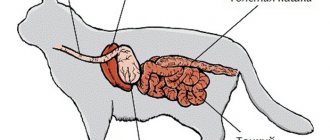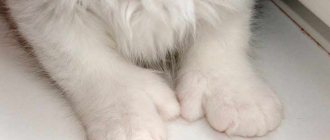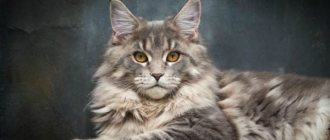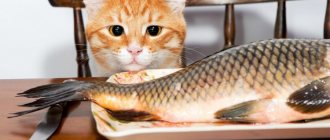Pleurisy in cats is an inflammatory process located on the serous membrane (pleura), which covers the lungs and other organs of the animal’s chest. There are two types of pleura: visceral and parietal. The first is located on the pet’s lungs, and the second lines the chest from the inside, covering the diaphragm and mediastinum. In the gap between these two serous membranes there is a pleural cavity, the main essence of which is the presence of a special fluid that acts as a lubricant that softens the friction of the lungs during movement.
The danger of pleurisy is that the focus of the disease not only develops on one of the most important organs of the pet’s body, but is also located in close proximity to the heart. Regardless of the type of disease, it has an extremely negative impact on the well-being of your furry friend. Pleurisy that is not detected in time can lead to a fatal outcome in a cat in a fairly short time. The article will discuss what types of pathology there are, its signs and symptoms will be listed, and methods of treating pleurisy will also be discussed.
Why does pathology develop?
The pleural cavity can become inflamed under the influence of the following factors:
- heart failure, which is complicated by tumors;
- lack of protein in the body;
- impaired vascular permeability;
- disruptions in the lymphatic ducts;
- progressive accumulation of chyle in the pleural cavity, flowing from the thoracic duct;
- diaphragmatic hernia.
In addition, pneumonia can be caused by a viral, fungal or bacterial type of illness.
Classification of the disease
Depending on the origin, pleurisy in cats is divided into 2 types:
The disease may be a consequence of a metastatic tumor of another organ in the animal.
- Primary. The serous membrane appears directly in the affected area.
- Secondary. It develops under the influence of other ailments that are localized in neighboring internal organs and spread to the pleura. We are talking about cancers that metastasize, as well as other diseases of the respiratory system.
Pleurisy that affects cats is classified based on the course of the disease:
- chronic;
- spicy;
- subacute
According to localization, pathology is divided as follows:
- Local. The inflammatory process is localized in one place.
- Diffuse. Inflammation is scattered throughout the serous membrane.
- One-sided. The left or right side of the sternum is affected.
- Double sided. The inflammatory process is localized on both sides at once.
Classification according to the nature of the course:
With this disease, effusion may form.
- Exudative. Purulent effusion is released into the pleural cavity.
- Dry. The exudate consists of protein fibrinogen and does not settle on the serous membranes, due to which effusion fluids do not accumulate in the pleural cavity.
The disease is also divided according to the degree of the inflammatory process:
- serous;
- serous-fibrous;
- fibrous;
- hemorrhagic;
- ichorous;
- purulent.
Pleurisy in cats - causes and dangers of pathology
An inflammatory process that occurs in the area of the serous membrane covering the organs of the chest is called pleurisy. Pleurisy in cats occurs as a result of viral and bacterial lesions, as well as inflammatory processes developing near the membrane. Malignant tumors, such as lymphosarcoma or mesothelioma, also contribute to the development of pleurisy.
Pleurisy most often develops not as an independent disease, but as a complication of a severe infectious process, characterized by decreased appetite, lethargy of the animal, impaired breathing and heartbeat. It is important to know the main symptoms and signs of pleurisy in cats in order to promptly contact a veterinarian for help.
Causes and types of disease
Inflammation of the pleura in human and veterinary medicine is classified depending on the course, origin, nature of the course and location of the pathological process.
According to the course, the forms of pleurisy are determined - acute, subacute and chronic. Each form of the disease has its own speed and timing of development. Thus, in acute forms of pleurisy, deterioration in the pet’s condition is noted 2 weeks after the onset of the pathology. The subacute form of inflammation of the pleural membrane takes from 1 to 3 months.
The danger of chronic pleurisy lies in its sluggish process, which takes from several months to 2-3 years.
The origin of pleurisy is also important when making a diagnosis and developing a further treatment regimen. Based on its origin, pleurisy is divided into primary and secondary. With primary inflammation of the pleura, the serous membrane is directly affected. The secondary type is characterized by the development of inflammation against the background of diseases of the pulmonary structures or heart.
Localization of pleurisy is local and diffuse. Local localization of inflammation of the pleura is characterized by the development of the pathological process in one limited place. Diffuse pleurisy affects the entire serous membrane or certain parts of it.
It is worth mentioning that pleurisy can be unilateral or bilateral, affecting one or both sides of the chest, respectively.
The nature of the flow is also of no small importance. Pleurisy can be dry and exudative. With the exudative type of pleurisy, purulent contents are released onto the surface part, and with dry, purulent exudate contains predominantly fibrinogen, which easily coagulates and does not settle on the surface.
The main causes of pleurisy in cats are:
- infectious diseases in cats caused by fungal, bacterial or viral microorganisms;
- inflammatory processes in the lungs or heart (abscesses, pneumonia);
- malignant neoplasms in any organ with metastasis;
- pathologies of the liver and digestive tract, causing hypoalbuminemia (low percentage of protein components in the liquid part of the blood);
- mechanical damage to the chest area (as a result of severe injuries and bruises);
- diaphragmatic hernia;
- pulmonary thrombosis (provokes a violation of blood circulation in the pulmonary structures and causes an inflammatory process);
- penetration of air, blood or lymph into the chest;
- diseases of the kidneys and pancreas.
Factors that provoke the development of pleurisy can be an unbalanced diet of the animal, prolonged stress, hypothermia, or increased physical activity.
Symptoms of pleurisy in animals
Signs of the inflammatory process developing in the pleura in cats depend directly on the stage, location and form of the process. Characteristic signs of inflammation of the serous membrane are:
- disturbance of the animal’s breathing rhythm (the cat makes superficial movements when breathing through the chest);
- apathy and lethargy of the pet;
- a sharp decrease in appetite;
- asymmetrical type of breathing (the side of the chest where the inflammatory process occurs lags behind the healthy one when breathing);
- noise in the sternum when breathing.
The painful sensations experienced by the cat when breathing make it meow pitifully and ask for help. With a strong exudation of pus, the pet’s general condition worsens - the visible mucous membranes acquire a bluish tint, blood pressure levels decrease, and the urine becomes dark with a repulsive, pungent odor.
One of the characteristic signs of bilateral pleurisy is the forced posture of the pet. The cat sits and stretches its head unnaturally forward, trying to take a full breath. The prognosis for the development of inflammation in the serosa of the chest is always cautious, and sometimes unfavorable. This depends on the speed of treatment started, the body’s own strengths and the reasons that caused the pathology.
Diagnosis and treatment of pleurisy
Diagnosis of pleurisy includes a set of examinations - a clinical examination using tapping and listening methods. As a rule, if pleurisy is suspected, an animal undergoes X-ray and ultrasound examination of the chest area.
When the suspected diagnosis is confirmed, the veterinarian prescribes a general blood and urine test. This is necessary to specify and identify the main cause that caused the onset of pleurisy. It is possible to perform a puncture of the pleural cavity to collect purulent exudate and further study it.
The animal must be treated immediately as soon as the diagnosis is confirmed. Any delay can cost your pet's life. In the vast majority of cases, pleurisy occurs against the background of a bacterial infection. Potent broad-spectrum antibiotics are used to treat and eliminate the source of inflammation.
Symptomatic therapy includes the use of:
- painkillers;
- antipyretics;
- diuretic medications (allows you to relieve swelling);
- multivitamin complexes and immunostimulants (increase the body’s own resistance to fight the disease).
If there is a strong accumulation of purulent effusion in the area of the pleural membrane, surgical drainage is performed. This is carried out using a special needle, which is inserted into the affected part to pump out the exudate. The cleaned pleural cavity is washed using special antiseptic preparations.
Prevention
In order to prevent the development of pleurisy, it is necessary to closely monitor the health of your pet. Any infections that develop in a cat should be treated promptly. Particular attention should be paid to a pet with respiratory infections, which most often cause complications.
Prevention of the inflammatory process in the pleura includes the selection of a balanced diet and compliance with pet care standards. It is important to prevent your mustachioed pet from becoming hypothermic and to ensure that the animal is not injured.
In case of any problems in the cat’s health, it is important not to delay, but to immediately contact a veterinary hospital. Pleurisy rarely goes away on its own, and in the acute form of the disease, if no help is provided, the animal dies within a few days.
Source: https://zen.yandex.ru/media/ivethelp/plevrit-u-koshek-prichiny-i-opasnost-patologii-5d4e71b278125e00add82395
What symptoms indicate the disease?
In cats, pleural disease causes the following symptoms:
In this state, the animal assumes a forced sitting position with its head extended.
- difficulty breathing;
- sitting position with head extended;
- change in the shade of the mucous membranes to blue;
- breathing not through the nose, but through the mouth;
- loss of appetite;
- weakness;
- apathy.
What to do if a cat has pleurisy?
In most cats and cats, bilateral inflammation develops, which is not localized, but covers the entire thoracic region. Lack of timely monitoring can lead to death. With pleurisy, the pulmonary region and heart are at risk, and these are vital systems of the pet’s body.
In case of illness, the pleural surface is filled with moisture. In a normal healthy state, the pleura in the chest also releases moisture, but this amount is enough for “basic” processes to occur. When the fluid volume is exceeded, the pressure on the organs increases. If treatment is not organized, pathologies with the lungs and heart cannot be avoided.
© shutterstock
Why does pleurisy appear?
Among the causes of disease in cats, a number of factors stand out::
- Heart failure and subsequent tumor. The appearance of a tumor increases pressure, which negatively affects the condition of the pleura and becomes the cause of pathology.
- Low protein levels. A small amount of the protein component is a consequence of diseases of the intestines and stomach. This can also lead to pleurisy.
- Violation of vascular permeability. When blood vessels lose their tightness, the level of moisture in the chest increases. This happens mainly due to allergies and other congenital ailments.
- Disturbances in the lymphatic ducts. A sharp increase in pressure stimulates intense penetration of fluid into the chest, which directly affects the cat’s condition.
- Chylotrax and diaphragmatic hernia. These are pathologies, after which (without timely treatment) the inflammatory process rapidly develops.
Another cause of pleurisy is hemotrax or blood entering the chest area. This may also be due to the formation of a blood clot in the lungs.
Pleurisy refers to a number of symptoms:
- Difficulty breathing. The cat begins to breathe heavily and sharply. Moreover, the pet breathes intermittently, with varying intensity. This indicates a severe form of the disease.
- Sitting position with head extended. If there is an illness for a cat, this is the only position in which the pet can breathe. If the animal remains in this position for too long, the alarm should be sounded.
- Blue discoloration of the mucous membrane. This is cyanosis - a process in which all mucous membranes on the cat’s body that are visible to the owner begin to take on a bluish tint. This is due to increased pressure on internal organs.
- Mouth breathing. When a cat's condition reaches a critical level, the pet cannot breathe through its nose. The cat begins to make characteristic sounds with its mouth.
- Loss of appetite and apathy. The cat feels a deterioration in its condition and senses a danger to its life. Apathy and panic, subsequent lethargy indicate that you urgently need to consult a specialist.
Symptoms of serous pleurisy vary from person to person, but there are also general signs. This is an unusually wide open mouth and too rapid breathing, which makes you pay attention to the cat. A veterinary examination is the only way to determine the exact cause of health problems.
© shutterstock
How is diagnosis and therapy carried out?
Inflammation of the pleura in cats and dogs is a common disease. This does not mean that you can get rid of the disease on your own at home. It is almost impossible to identify the disease in time at the formation stage. Further diagnosis without the use of medical equipment is problematic.
The presence of fluid in the chest cavity is detected by ultrasound. The effusion is highlighted on photographs and radiographs. In addition, the doctor performs listening and tapping, which cannot be done without the appropriate skills and knowledge.
The next way to diagnose pleurisy is to collect tests. Blood and urine fragments are collected. This helps to register the primary pathology - what led to the formation of the disease. This is what becomes the basis for developing a treatment program.
Prognosis for pleurisy
If you do not pay attention to the condition of your pet, pleurisy will inevitably lead to death. The animal cannot get rid of the disease on its own. The moisture will gradually increase the pressure to a critical level, after which the cat’s heart will stop or the pet will simply suffocate from pleurisy.
The course of treatment for pleurisy is individual and the exact timing is discussed with the doctor, as is the treatment program. Rehabilitation cannot be interrupted: the risk of relapse is high, and the cat may not survive a second blow. Adults and elderly individuals, whose bodies can no longer withstand taking toxic and potent drugs, are at particular risk.
With timely treatment and qualified assistance, recovery from pleurisy does not take more than 3-4 weeks. But this does not apply to the chronic form. In this case, the treatment period extends over months and even years: the diet and medications are selected according to the pet’s individual tolerance.
Chronic pleurisy is not a death sentence. If you follow the recommendations of a specialist, the cat will not experience problems, and may even live longer due to the constant stimulation of the body with vitamins and nutrients.
Source: https://KoshkaMurka.ru/9124-chto-delat-esli-u-koshki-plevrit.html
Diagnostic measures
If owners suspect that pulmonary pleurisy has occurred in cats, it is important to contact a medical facility as quickly as possible. At the appointment, the doctor will conduct a survey of the animal’s owners, during which he will find out how long ago the unwanted symptoms began. Then the veterinarian begins tapping and listening to the chest. To confirm the preliminary diagnosis, the pet is sent for the following examinations:
- ultrasound examination, which allows you to determine whether there is fluid in the chest cavity;
- X-ray of the sternum;
- general and biochemical blood tests;
- puncture of the chest followed by sending the resulting effusion to the laboratory.
Pleurisy in cats
Pleuritis is an inflammation of the pleura that occurs in animals of any age, sex and breed. The pleura is a serous membrane that lines the inside of the chest cavity and also covers the lungs.
The pleura forms symmetrical right and left sacs, the space between which is called the mediastinum. The mediastinum contains the trachea, esophagus, heart, large blood vessels, lymph nodes, and nerves.
A special feature of the pleura is that between its layers there are slit-like cavities that contain a small amount of serous fluid. It is needed to reduce the friction force of the pleura during breathing.
In addition, each pleural layer has microscopic slit-like openings in the mediastinum. Under unfavorable conditions, this contributes to the rapid transition of pathological processes from the pleura to the lungs and vice versa.
Treatment of pathology
To alleviate the condition, the pet needs a thoracentesis.
If pleurisy is diagnosed in a pet, it is important to start treatment as quickly as possible, since the undesirable symptoms characteristic of this disease lead to respiratory failure. In the absence of appropriate treatment, death cannot be ruled out. Veterinarian Maria Aleksandrovna Voitekha notes that therapeutic measures begin with the elimination of excess moisture. For these purposes, thoracentesis is performed, which is a procedure for puncturing the chest wall to enter the pleural cavity. Before the procedure, the animal is usually given local anesthesia.
After this procedure, they resort to surgical intervention, which is considered the most effective and safe method of treating pleurisy. This is the only way out that will prevent complications and death. Postoperative treatment includes the prescription of antibacterial medications, which make it possible to avoid infection. Antimicrobial medications are also prescribed. Often medications are given orally, however, if the cat's condition is severe, pharmaceuticals may also be prescribed intravenously. Therapy is completed with medications that improve the functioning of the cardiovascular system.
Pleurisy in cats: treatment, symptoms, prognosis and classification
Pleuritis is an inflammation of the pleura that occurs in animals of any age, sex and breed. The pleura is a serous membrane that lines the inside of the chest cavity and also covers the lungs.
The pleura forms symmetrical right and left sacs, the space between which is called the mediastinum. The mediastinum contains the trachea, esophagus, heart, large blood vessels, lymph nodes, and nerves.
A special feature of the pleura is that between its layers there are slit-like cavities that contain a small amount of serous fluid. It is needed to reduce the friction force of the pleura during breathing.
In addition, each pleural layer has microscopic slit-like openings in the mediastinum. Under unfavorable conditions, this contributes to the rapid transition of pathological processes from the pleura to the lungs and vice versa.
Classification of pleurisy
By origin, pleurisy is primary and secondary.
Primary pleurisy is a lesion of the pleura itself, when the process of inflammation initially develops in its tissues.
And secondary pleurisy is a complication of the disease of neighboring organs. In this case, first, for example, lung diseases, tumor processes, etc. arise, and after this the inflammation spreads to the pleura. Secondary pleurisy is much more common than primary pleurisy.
According to the course, pleurisy can be acute, subacute, or chronic.
A cat usually suffers from acute pleurisy for up to 14 days, subacute can last up to 1.5 months, and chronic pleurisy lasts for several months or even years.
Based on the localization of the process, a distinction is made between limited, that is, local pleurisy, and diffuse, which spreads in different places of the pleura.
Unilateral pleurisy can affect the right or left side of the chest cavity, and bilateral pleurisy can affect both.
Depending on the nature of the process and the presence of effusion, pleurisy can be wet or dry.
With wet pleurisy, inflammatory fluid is released into the pleural cavity. The composition may be dominated by blood, pus, protein, microorganisms and fragments of decayed tissue.
With dry pleurisy, the exudate is rich in protein - fibrinogen. It easily curls up and settles on the surface of the pleura, while liquid does not accumulate.
Diagnosis of pathology
A veterinarian can make a preliminary diagnosis based on a visual examination of a sick cat. When percussing the chest, the physician will detect dullness in the lower part of the lung. The upper limit of dullness is located in the horizontal direction, even if the position of the animal’s body changes.
An effective diagnostic method for suspected hydrothorax is an X-ray examination of the chest area. The accumulated serous fluid is detected in the form of a continuous darkening of the lower half of the pulmonary field. The horizontal upper limit of darkening fluctuates during the animal's breathing period.
X-ray of the chest of a cat with hydrothorax
A diagnostic method such as transudate examination is informative. A fluid sample is obtained by puncture. A distinctive feature of transudate with thoracic hydrops is its protein content below 3%.
First of all, it is necessary to exclude pleurisy in the animal, which usually occurs with an increase in temperature. If a higher than 3% protein concentration is detected in the test fluid taken during puncture of the chest cavity, the doctor may suspect pleural inflammation in the pet.
In order to carry out a differential diagnosis, the animal is prescribed a clinical and biochemical analysis of blood, urine, coprological examination, electrocardiography of the heart, ultrasound examination of the myocardium, liver, kidneys and other organs. The prognosis is often cautious or unfavorable.
To see what hydrothorax looks like in a cat during an ultrasound examination, watch this video:
Causes of pleurisy in cats
Factors that cause inflammation can enter the pleura from the lungs, through the bloodstream or lymphatic system.
These include:
1. Pathogens: viruses (for example, FIP), bacteria (cocci), fungi, protozoa, helminths.
2. Inflammatory processes that spread to a number of underlying organs. For example, from the lungs (pneumonia, abscesses), pericardium, etc.
3. Tumors of the lungs, esophagus, mediastinal lymph nodes or other organs of the chest cavity.
4. Injuries and operations on the pleura and chest.
5. Pathologies of the abdominal organs:
- pancreatitis;
- renal failure (uremic pleurisy);
- When the diaphragm ruptures, organs are displaced from the abdominal cavity into the chest cavity and compress the lungs, causing inflammation of the pleura.
6. Taking medications, for example, furadonin.
7. Predisposing factors: spring - autumn period, hypothermia, overwork, unbalanced nutrition and transportation, weakened immunity, stress.
Symptoms of the disease
The symptoms of the pathology depend entirely on the form of the pathology. The differences are especially pronounced depending on whether exudate accumulates in the pleural cavity. The most typical general symptoms include:
- rapid breathing of the animal, as well as superficial respiratory movements;
- the pet’s apathy, its reluctance to get up from its favorite place again;
- decreased or complete lack of appetite;
- if the disease is expressed in a unilateral form, then the cat’s breathing becomes asymmetrical, since the affected side lags behind when inhaling and exhaling;
- If the owner puts his ear to the cat's chest, he can hear a characteristic noise (leaves of the serous membrane rubbing against each other).
To determine dry pleurisy, there are a number of signs, which include the pet being forced to lie on the side where the pathological process takes place, since arching in the opposite direction causes suffering to the cat. Breathing causes pain to the animal; the cat tries to attract the owner’s attention with a plaintive meow.
If purulent effusion accumulates abundantly in the pleural cavity, the cat’s condition quickly deteriorates. The pet's mucous membranes turn blue, blood pressure decreases, its urine takes on a dark tint and emits an unpleasant odor.
In addition, the furry fidget suffers from severe shortness of breath and cough with a small amount of sputum.
If pleurisy has affected both sides of the chest, then the only position in which the cat is able to breathe fully is sitting and with its head stretched forward.
Exudative pleurisy in cats is an extremely dangerous disease; if the animal is not provided with qualified therapy in the very near future, it will die. It is possible to remove fluid from the pleural cavity only in a veterinary clinic; it is impossible to do this at home.
Symptoms of pleurisy in cats
- Depression, elevated body temperature; the mucous membranes of the oral and nasal cavities, the conjunctiva are bluish in color. In severe cases, exhaustion occurs.
- Respiratory system disorders: - shallow rapid breathing, increased heart rate, dry painful cough; - shortness of breath with exudative pleurisy with difficulty breathing; - if the layers of the pleura grow together as a result of inflammation, then abdominal breathing is observed, which is carried out due to contraction of the diaphragm and the abdominal wall; - with unilateral exudative pleurisy with a large amount of fluid, the chest becomes asymmetrical during breathing, and the cat takes a forced position that makes breathing easier;
- Pain in the chest when feeling and listening;
- Brown, foul-smelling urine, dry feces.
How is the treatment carried out?
The promptness of medical intervention determines the risks for the cat. With inflammation of the cat's pleura, respiratory failure begins to rapidly develop and spread. Death is a likely consequence if appropriate measures are not taken. Costal pleurisy is a serious threat, so there is no time to waste.
The first stage of treatment is the elimination of excess moisture. For such purposes, a procedure called thoracentesis is performed. A thin needle is placed into the chest area. The cat is usually kept under an oxygen mask. Thoracentesis removes moisture and helps to conduct an initial diagnosis of the pet’s condition.
Surgery becomes the only way to avoid death for some symptoms. This applies to situations where a rupture of the lymphatic duct is detected.
Accompanying therapy for pleurisy involves the use of antibiotics and antimicrobials. If the cat’s condition is serious, substances are administered intravenously. The treatment program includes medications that counteract intoxication and normalize the functions of the cardiovascular system.
Diagnosis of pleurisy in cats
First of all, the doctor collects information about the animal’s life history and disease. This is followed by a clinical examination, thermometry, and auscultation (listening to breathing). With dry pleurisy, auscultation reveals a pleural friction rub. Putrefactive pleurisy corresponds to the sound of splashing.
A necessary study is x-ray diagnostics, which shows the presence of pathological fluid in the chest cavity. In addition, the image usually shows the general condition of the heart and lungs.
Pleurisy in cats - radiograph in the right lateral projection
To assess the severity of the condition and the severity of the body's response to the disease, a general clinical blood test will be needed. It pays attention to the increase in neutrophilic leukocytes.
To study the nature of the exudate, thoracentesis may be required - a puncture of the chest wall.
Also, as necessary, diagnostic measures are carried out for concomitant diseases.
Treatment of pleurisy in cats
First of all, to treat pleurisy, you will need antibiotics, sulfonamides, analgesics, multivitamins, diuretics, as well as other drugs, based on the symptoms of concomitant diseases.
For purulent and putrefactive pleurisy, thoracentesis is used. It is necessary to remove exudate, followed by washing the pleural cavity with antiseptic solutions.
Prerequisites for a speedy improvement in well-being and recovery are rest and a balanced diet.
Chylothorax
What is chylothorax? Chylothorax is a relatively rare condition in cats in which lymph fluid accumulates in the pleural space. The pleural cavity is located between the lungs and the inner lining of the chest wall.
Typically, the volume of fluid in the pleural space is equal to a teaspoon (5 ml). The purpose of the fluid is to keep the surface of the lungs lubricated so they don't stick to the chest wall. When chylothorax is present, the volume of fluid increases sharply, up to 1 liter.
1. Pleurisy. This means that an abnormal amount of fluid accumulates in the pleural space surrounding the lungs. This buildup prevents the cat from expanding his lungs fully, causing the cat to breathe quickly and shallowly (a symptom of shortness of breath). In some cases, this condition leads to respiratory failure and death.
2. Instead of the usual clear fluid in the pleural cavity, we notice milky juice, milky white fluid from the thoracic duct or canals (chyle). This unique type of fluid from the lymphatic drainage of the gastrointestinal tract has a high triglyceride content, which gives it a distinct color and chemical composition.
Is there a breed predisposition in cats?
Siamese and Himalayan breeds in particular are at risk of developing chylothorax. Both sexes are equally susceptible.
What are the clinical signs of chylothorax?
The main clinical sign of chylothorax is difficulty breathing and shortness of breath. Some cats present with the symptom of "bad breathing" because there is a delay between inhalation and exhalation. Interestingly, coughing is often the first sign of chylothorax in some cats.
In some situations, clinical signs of an underlying disease, such as tumors or heart failure, may be hidden due to pleurisy. Sometimes owners do not notice any changes in behavior other than depression or exercise intolerance.
In some cases, chylothorax may be caused by injury or increased pressure within the thoracic duct or vena cava. Trauma can cause the thoracic duct to rupture. Automobile injuries or falls from a height injure the chest cavity and are the most common causes of traumatic chylothorax.
If the cause cannot be identified after appropriate diagnostic procedures, chylothorax is considered idiopathic. More than 50% of all cases of chylothorax belong to this category.
Source: https://dk35.ru/veterinariya/auskultaciya-legkih-pri-plevrite-u-koshek.html
Prognosis for recovery
If the owner does not closely monitor the behavior and changes in the condition of the pet, pleurisy will cause the death of the pet. The disease cannot go away on its own. The fluid that accumulates increases the pressure to critical levels, as a result of which the cat experiences cardiac or respiratory arrest. Therapy is selected individually for each specific animal. This also applies to the duration of treatment. It is important that interrupting the course is strictly prohibited, since the likelihood of a relapse increases, which the pet may not survive.
If the prognosis is favorable, the pet’s therapy will last at least a month.
When the disease is diagnosed at an early stage, doctors make a favorable prognosis. In this situation, therapy takes about 1 month. If we are talking about the chronic stage of pleurisy, treatment can take a lifetime. In this case, the prognosis is not always favorable. Owners will need to constantly give the animal the required medications prescribed by the veterinarian, as well as normalize the cat’s diet. It is recommended to exclude fatty foods, spicy and sweet foods. Fermented milk products, fish, chicken and pork will be useful for a sick animal. However, these foods should be given in limited quantities.
Diagnostics and therapy
Diagnosis is based on medical history and clinical signs, the presence of fluid in the chest cavity (checked by ultrasound), and chest x-rays. Percussion and auscultation (tapping and listening) are of great importance. Blood and urine tests are useful in identifying the primary pathology that led to the development of inflammation of the pleural cavity. For the same purpose, it is very useful to analyze the effusion obtained during diagnostic punctures of the chest.
Let us repeat once again that treatment of pleurisy in cats should begin immediately, immediately after detecting any of the clinical signs and confirming the diagnosis. It is important to understand here that cats develop decompensated respiratory failure very quickly, and therefore, if delayed, death is quite possible. Do not practice treatment at home, as this will deprive your pet of precious time that could be used for normal therapy.
The most important goal of treatment is the immediate evacuation of accumulated fluid or effusion in the chest cavity. A procedure called thoracentesis is responsible for this. A thin needle is inserted into the chest. This method is both therapeutic and diagnostic. The animal may need to be kept under an oxygen mask until this procedure is performed.
Preventive actions
To prevent pleurisy from occurring in a cat, owners will need to carefully monitor their pet. It is important to protect him from hypothermia and not let him go outside during the cold season. It is not recommended to bathe a cat in winter, especially if there is no heating in the room. It is important to prevent injury to your pet and monitor its diet. The menu should include food containing sufficient amounts of microelements and vitamins. They are found in fish, boiled potatoes, and legumes.
Veterinarians specify that the cat can get the components from vitamin-mineral complexes, which are presented in a wide range in pharmacy chains. Before using medications, you should consult a veterinarian. It is important to treat any diseases, especially the respiratory tract, as they are often responsible for the development of pleurisy. Pet owners should visit a veterinary clinic at least once every six months for a routine examination of their cat.
Purulent pleurisy - pyothorax
Its symptoms come on suddenly. Your cat lived an ordinary life, was cheerful and playful, but suddenly you notice that she is breathing quickly and with difficulty, she has a fever, she has become lethargic and apathetic. It is possible that liquid pus has accumulated in the animal's chest. Often the causes of pyothorax cannot be determined, but the most common are trauma and wounds of the chest and subcutaneous abscess. Even the most harmless at first glance bite wound can become a cause for the development of a disease and have serious consequences. Regardless of the cause, this disease is very serious. Treatment should be started immediately and always by a veterinarian.










